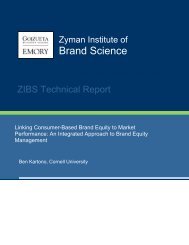surprising that they deliver revenue,not cash flow. If the objective is <strong>to</strong>maximize volume, sales people arelikely <strong>to</strong> reduce prices wheneverpossible, promise faster delivery,and figure receivables are someoneelse’s problem. However, each ofthese objectives undercuts marginsand reduces asset turnover.Cus<strong>to</strong>mers with less predictabledemand who want faster deliveriesresult in inven<strong>to</strong>ry levels. Cus<strong>to</strong>merswho do not pay in time result inreceivables. By decreasing thenumera<strong>to</strong>r (margins) and increasingthe denomina<strong>to</strong>r (assets), thesesales tactics ultimately reduce ROA.Marketers’ failure <strong>to</strong> recognize theimportance of margins can lead <strong>to</strong>results that are quite suboptimal. Forexample, if a price elasticity estimateof -2 (say a 1 percent decrease inprice leads <strong>to</strong> a 2 percent increase involume) would support a price-cutdecision, such a decision woulddecimate profits if the net marginwere 10 percent. This is because a 1percent price decrease would lead <strong>to</strong>a 10 percent margin decrease andthe 2 percent increase in volumewould lead <strong>to</strong> a shortfall of 8 percentin contributions <strong>to</strong> profit. Becausemarketers (including researchers andacademics) often deal with volumeand share information alone, theiractions are more prone <strong>to</strong> producesales than economic profits—the keyobjective of the enterprise.Some marketers focus on metricssuch as growth in sales and marketshare <strong>to</strong> report the impact of theiractions. This should be extended <strong>to</strong>include a discussion of the impact onmargins, working capital, and cashflow.While simplicity, structure, anddefinitional clarity helped the DuPontmodel come a long way,unfortunately, it also raises manyconcerns from a marketer’sperspective. First, marketingexpenditures are listed as expensesrather than investments. This impliesthey generate only a short termimpact and do not contribute <strong>to</strong> evensemi-durable assets. Thus, allmarketing activities must typically“pay” for themselves within a shorttimeframe. To the contrary, it hasbeen argued that market-basedassets such as cus<strong>to</strong>mers and brandsare the only assets that appreciate,and not depreciate (Lusch andHarvey 1984; Srivastava et al 1998).Second, managers often focus much<strong>to</strong>o-muchattention on managing ROI(or, in the case of marketingmanagers, ROMI) rather thanmanaging the firm value. Strongbrands leveraged in down marketscan wrest market share frombeleaguered competi<strong>to</strong>rs (Buzzelland Gale 1987). Adverse economicconditions that may lead <strong>to</strong> lowerROMIs often result in reductions inmarketing investments. Ironically,for strong companies, this may bethe best time <strong>to</strong> go on an offensivebecause less robust competi<strong>to</strong>rs maybe weaker still (Srinivasan,Rangaswamy and Lilien 2005) . It isalso the case that much of theimpact of marketing is on spendingrelative <strong>to</strong> competition. During weakeconomic times, competitivespending using the same logic wouldbe down. Thus, high levels ofrelative spending are easier <strong>to</strong>achieve. This reasoning, amongothers, has resulted in a debate onthe relative value and usefulness of“R over I” versus “R minus I” withstrong advocacy for the latter (Doyle2000; Ehrbar 1998). The latter isoften measured via the economicvalue added (EVA) and representsZyman Institute of Brand Science 8
cash flow from an opportunityadjusted for the cost of resourcesused <strong>to</strong> generate the cash flow.Third, all accounting-basedmeasures (including the DuPontmodel) are retrospective. This maynot pose a problem in mature, stablemarkets where the future isexpected <strong>to</strong> be similar <strong>to</strong> the past.However, in dynamic marketssubject <strong>to</strong> product and marketplacechanges, looking at what ishappening may not be the best forplanning forward. By its nature, thetendency <strong>to</strong> look at what hashappened, not what will happen,places <strong>to</strong>o much weight on shorttermresults, and does not recognizethe assets that have been createdwhich might lead <strong>to</strong> future sales, orrecurring cus<strong>to</strong>mers.Fourth, accounting metrics such asmargins and turnover favor matureproducts over new-<strong>to</strong>-marketinnovations that tend <strong>to</strong> have lowerturnover, lower net margins—andhigher marketing investmentrequirements (e.g., for cus<strong>to</strong>meracquisition). Invariably, use ofmetrics such as ROA or ROI swingsthe pendulum in favor of incumbentproducts thus starving innovations ofbadly need growth funds.Finally, performance metrics such asROA and EVA ignore risks andsacrifice future opportunities forshort-term earnings. Because risk isa principal determinant of a firm’sequity, this omission is critical(Martin and Petty 2000). Thus, newproducts or emerging markets,which typically have lower netmargins and turns and highermarketing investments, tend <strong>to</strong> losethe battle of resources <strong>to</strong> matureand established products andmarkets. In effect, companies aremore likely <strong>to</strong> invest in incumbentproducts and markets, starvingfuture opportunities if they focus onshort-term <strong>to</strong>ols like the DuPontmodel or EVA. Prospects with longertermpayoffs must be evaluated bymeasures that give credit <strong>to</strong> suchpayoffs – such as net present value.Despite the reservations associatedwith short-term performancemeasures, they represent the mostfrequently used metrics. Thus,marketers must learn <strong>to</strong> use them <strong>to</strong>justify request for resources, or atleast show other metrics thatdemonstrate the long-term value ofthe created marketing assets. Wemust note that, increasingly, financeand accounting professionals aremoving <strong>to</strong>wards cash flows ratherthan earnings-based metrics (e.g.,CFROI rather than ROI), asearnings-based measures aresubject <strong>to</strong> manipulations related <strong>to</strong>depreciation (Martin and Petty2000). Additionally, as marketinghas long-term effects, we need <strong>to</strong>learn how <strong>to</strong> better capture andexpress forward-looking benefits,such as through NPV measures andprojected cash flows.2.2 <strong>Linking</strong> Market-Based Assets <strong>to</strong>Shareholder ValueCompanies must allocate resources<strong>to</strong> invest in market-based assets andcapabilities (Day 1994). Theseinvestments must be justified inmuch the same terms as otherbusiness assets. For example,investments in informationtechnology can be leveraged <strong>to</strong>enhance efficiency of supply-chainprocesses (reduce costs as aconsequence of lower inven<strong>to</strong>ries),drive sales (e.g., via betterprospecting based on data-mining),and lead <strong>to</strong> more satisfied cus<strong>to</strong>mersZyman Institute of Brand Science 9
- Page 1 and 2: Zyman Institute ofBrand ScienceZIBS
- Page 3 and 4: Linking Marketing Metrics to Financ
- Page 5 and 6: contrary, over the past few decades
- Page 7: way in being accepted as a standard
- Page 11 and 12: value, the first step might be tobe
- Page 13 and 14: 3.1 Our conceptual frameworkTo outl
- Page 15 and 16: This next level of linkages isexplo
- Page 17 and 18: imagined, and moreover, notimperati
- Page 19 and 20: proposed above? We illustrate below
- Page 21 and 22: One interesting example in thiscont
- Page 23 and 24: satisfaction levels may go up, butc
- Page 25 and 26: assets. They represent investmentsw
- Page 27 and 28: discounted cash flow analyses. To b
- Page 29 and 30: REFERENCESAaker, David (1991), Mana
- Page 31 and 32: Farris, Paul, and David Reibstein (
- Page 33 and 34: Mizik, Natalie, and Robert Jacobson
- Page 35 and 36: Veliyath, Rajaram, and Stephen Ferr
- Page 37: Contacts:For further information, p





